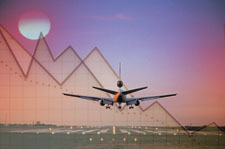Delta Airlines cuts fares in a price war that Merrill Lynch estimates will sap $2.5 billion in revenues from the six largest airlines. US Airways and United file for bankruptcy, and almost every other airline — Southwest is one of the exceptions — reports significant losses. The cost of oil remains stubbornly high, adding significantly to cost pressures. The question is: How do you fix an industry littered with walking zombies?
Wharton professors have a few suggestions. First and foremost is to liquidate a few airlines — allowing them to die, and most importantly, to stay dead. Only then will enough capacity be removed from the industry to let carriers turn a profit. “If one airline goes under it will strengthen the others,” says business and public policy professor Elizabeth Bailey. “There are too many carriers and too much capacity. This industry hasn’t been in equilibrium as long as I have been watching it.” W. Bruce Allen, also a business and public policy professor, agrees. “My big complaint with this industry is that you ought to be able to die,” says Allen, referring to the numerous lifelines thrown to carriers, like US Airways, by bankruptcy judges.
Airline executives acknowledge the industry’s problems. “The revenue environment continues to be a challenge due to the glut of airline seats,” said Southwest CEO Gary C. Kelly in a recent company earnings release. In a Delta earnings report, CEO Gerald Grinstein spoke of “the difficulties our airline will continue to face in 2005” while Continental CFO Jeff Misner noted that his airline has cut $900 million in costs and still lost $363 million in 2004.
Part of the problem is history. Legacy carriers such as American and United were formed when airlines were regulated, in part to provide stability for what was then a young industry. Under that system, airlines could break even running at 50% capacity. When deregulation began in 1979, consumers benefited from lower fares, but the airlines never managed to overcome the liability of high fixed costs set during that earlier era. Today, 70% of airline seats are full and only one carrier (Southwest) is regularly profitable.
If even just a handful of airlines disappeared, Bailey estimates the industry could continue to keep prices reasonable, offer good service and make money. She suggests the job could be done with a total of nine carriers split into three areas: international travel (United primarily), domestic hub and spoke routes (Delta) and point-to-point flying (JetBlue and Southwest). “This industry, like others, is an oligopoly,” says Bailey. “How many domestic automakers do we have? Three (General Motors, Ford and DaimlerChrysler) and one is foreign owned. The airline industry should be like that.”
The big challenge is getting there. Here are three ways to do it.
Suggestion 1: Reform the Bankruptcy Process Take US Airways. The company is in its second Chapter 11 restructuring and Wharton professors are surprised that judges believe the airline can become a viable company again. “It’s ludicrous to allow a company to go bankrupt repeatedly,” says marketing professor David Reibstein. “The intent of bankruptcy is to help a company restructure and pay off its debt. A company should only be allowed in Chapter 11 if you believe it can survive.” His prognosis for US Airways isn’t good. Southwest is encroaching on US Airways’ Pittsburgh hub after taking on the airline in Philadelphia, a strategy that will probably be “the final nail in the coffin.” Whether the bankruptcy process needs to be reformed is unclear, but at the very least judges should do more due diligence, experts at Wharton say. “I think judges hearing cases need to really assess the ability of an airline” to get out of bankruptcy, suggests Reibstein. “It’s irresponsible for judges to think some of these companies can make it.” In the case of US Airways, Allen says it’s very possible that a judge will eventually pull the plug on the company even though it is currently winning concessions from employees to cut costs. United, the other airline in bankruptcy, may be able to emerge from Chapter 11 because of revenues it earns from international routes. Suggestion 2: Revamp Industry Work Rules According to Bailey, regulations and union work rules are two items that keep the industry from consolidating. For instance, the U.S. government prevents foreign acquisitions of domestic carriers. That means British Airways can’t buy US Airways to get access to more U.S. markets. “I’m sure a foreign carrier would buy US Airways because it would like access to the US Airways network,” says Bailey. The ban on foreign acquisitions is critical considering most domestic carriers don’t have strong enough balance sheets to pull off mergers. Any deals among carriers are small. For instance, Southwest bought gates and maintenance hangars at Chicago’s Midway airport from bankrupt ATA Airlines as an opportunistic purchase. Bailey also criticizes work rules dating back to the regulation era. For instance, legacy carriers are saddled with union rules that boosted salaries and limited the times a pilot can fly. As a result, Southwest pilots generally make less money and are twice as productive on average. (At Southwest, 80.2% of the employees are unionized, including pilots, but their deals are far less generous than those at older airlines.) Indeed, United has been negotiating with its pilots to save money and reset pay scales. The tactics were successful because pilots these days don’t have much a choice. Senior pilots who leave one airline to go to another start at the bottom rung, says Bailey, which means that pilots are basically forced to stick with their airline no matter how bleak its future. Analysts consistently “underestimate” the difficulties that work rules impose on airlines, she notes. In addition, according to Allen, the work rule issue affects airlines’ corporate cultures. Legacy carriers are more likely to have morale problems given the pay cuts employees must endure just to keep a job. At discounters such as JetBlue and Southwest, employees accept the lower wages when they accept the jobs. “It’s difficult to ask employees to work more for less and be happy about it,” says Allen. Legacy carriers, which are stuck with bloated payrolls, are now “trying to build a new culture in an old one.” Suggestion 3: Curb Investment in Airlines Maybe Wall Street is the problem. Despite all the challenges in the airline industry, investors are willing to buy airline debt and stock leading to a continuous crop of new competitors entering the market. That fact amazes Cappelli. “As long as the public is willing to fund cheap travel, these [overcapacity] issues will remain,” he says. “It’s a real puzzle why people invest in any airline with the exception of Southwest.” Allen acknowledges that it’s unusual for investors to be so willing to fund unprofitable companies, but adds that airlines in good times can generate a lot of cash — at least enough to pay debts to bondholders. In addition, Allen says, there is a good amount of “cowboy-ism” in the industry, but that’s how innovation and change come about. Although some upstarts, such as People Express, have failed, others, such as JetBlue, have been big hits. Meanwhile, there’s usually a mogul like Virgin’s Richard Branson who wants to own an airline. This investment interest can be beneficial because an influx of new carriers may eventually make the industry efficient. Younger fleets and new corporate cultures could push out inefficient legacy carriers over time, says operations and information management professor Serguei Netessine. For instance, Southwest pioneered the concept of standardizing its fleet — using only Boeing 737s and thus saving on training and maintenance costs. JetBlue brought in-seat television. “These companies can change the ball game,” he notes. Winners and Losers So assuming these suggestions are followed, what carriers will be left standing? Netessine sees six to seven carriers, with Southwest — which reported profits of $313 million in 2004 — being the only sure bet to survive. United Airlines should make it because it has international routes that are profitable and could provide a cushion against the cutthroat U.S. market. Continental and American should also be able to keep flying. US Airways is almost certain to fail, say Wharton experts, with Delta and its big gamble on cheaper fares skating along the path to bankruptcy. Indeed, Delta reported a $5.2 billion loss in 2004, more than what the International Air Transport Association estimated the entire global industry would lose for the year. (IATA’s estimate was $5 billion.) Discount airlines have the upper hand in the current environment because Delta’s price cuts, which were matched by rivals, will mostly affect revenue at legacy carriers, say analysts. Carriers like Southwest and JetBlue won’t be hurt at all. “We see little danger to pure discounters,” says Robert Ashcroft, an analyst at UBS Securities, adding that discounters have the most customer loyalty. Passengers will fly a carrier like Southwest even if it isn’t the absolute lowest fare. “We believe that’s because customers know they get a fair deal on Southwest and so don’t feel the need to expend the extra effort to look at alternatives.” Wharton professors, however, add that not all discounters are created equal. With the exception of Southwest, no discount carrier is a lock to survive. Allen suggests that it is wise to reserve judgment on JetBlue until it flies for a few more years. While JetBlue has been a big success thus far, the airline is still young; until it expands into new markets and has to maintain an aging fleet of airplanes — known as a maintenance cycle — the jury is out. In addition, salaries will increase as employees gain experience. All of those factors will raise JetBlue’s costs, says Allen. Southwest has already proven it can navigate those changes.
One of the largest problems facing the airline industry is the fact that companies rarely liquidate quickly. Typically, a struggling airline files for bankruptcy, cuts costs and emerges to put additional pressure on rivals. These rivals must then cut their own prices in order to compete, a strategy which forces them into bankruptcy. Repeat that process and you have an industry in a death spiral. “The problem is that the government allows a carrier to dramatically cut costs in bankruptcy and then push others into the financial abyss,” says management professor Peter Cappelli. “The industry is bleeding itself to death.”



